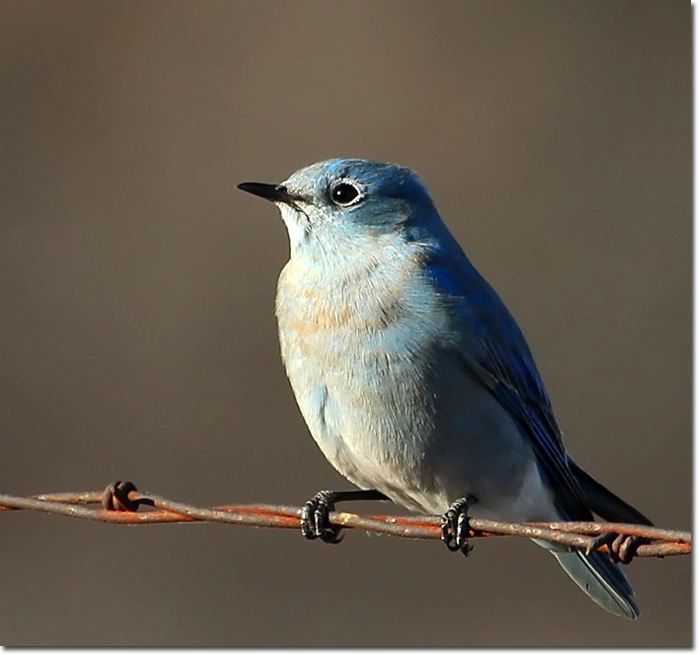
by John Shackford
The Mountain Bluebird (Sialia currucoides) is one of Oklahoma’s most beautiful birds. The male’s color is similar to, but prettier to me than, sky-blue. They are infrequent visitors to central Oklahoma in winter. Over the years we have had a handful of winter records during the Oklahoma City Christmas Bird Count. It is always a treat to see one. Wintering birds are found from central Oklahoma to the Black Mesa area of Cimarron County, generally increasing in numbers westward.
David Wiggins, a native of Norman now living in Sweden, was in the Black Mesa area in early October 2016. On the second and third of the month he was in Elkhart, in extreme southwestern Kansas, where he saw no Mountain Bluebirds. He found none in the Kenton area of northwest Cimarron County, Oklahoma, on the fourth and fifth. On the fifth he found perhaps 15-20 in northeastern New Mexico, two of which were only about a mile west of the Oklahoma state line. Thus, it appears that a few Mountain Bluebirds were just then (5 October) starting to arrive in the Black Mesa area, from the north and west.
Jack Tyler, Warren Harden and I visited the Black Mesa country later in the month. Jack and I were there from 18-23 October and Warren joined us for the last four days. Although we encountered a paucity of birds, in general, we did find Mountain Bluebirds more than a little common most days. As Jack and I first arrived late on the afternoon of 18 October we encountered Mountain Bluebirds, usually small groups numbering 8-20 birds, along fence lines. After Warren arrived on 20 October, we continued to enjoy seeing so many bluebird.
On 19 October, Jack and I drove southward from Black Mesa State Park to Wheeless, Oklahoma, a distance of 10 miles or so, through shortgrass prairie rangeland. We estimated seeing conservatively 130 Mountain Bluebirds, comprising about 95% of all birds seen. The birds usually flew up from roadside barbed wire fences.
On the morning of 21 October, the three of us were treated to bluebirds flying back and forth from a one-seeded juniper tree, where they were feeding, into a dead elm tree that was nearby. Our tents were in between these two trees. The many droppings the birds left on our picnic table had one-seed Juniper seeds in all or most of them. We continued to see an abundance of bluebirds all day on the 21st, most of them on fence lines, where they were likely hawking/catching insects for their food. So birds eating juniper berries and catching insects accounted for two methods of gathering food.
But the next day, 22 October 2016, was a different story. Most all the birds we had been seeing in the Black Mesa Country were gone, and we noticed only about 10% of the birds we had seen in the previous four days.
We speculated that the precipitous decline in Mountain Bluebird numbers might signal that these early flocks were continuing southward, likely to winter in Texas, New Mexico and Mexico. It was fascinating that our original perceptions had been wrong: we had expected the birds to have already arrived on their wintering grounds in Oklahoma. But apparently we had seen winter birds migrate in, then migrate out, to more southerly locations.
It will be interesting to see if this species shows up further east than usual this year in Oklahoma. American Horse Lake, near Geary in Blaine County, frequently has Mountain Bluebirds in some numbers in winter, the closest regular place they show up for us here in central Oklahoma.
This bluebird also has an interesting nesting history in Oklahoma. Perhaps 12-15 years ago I photographed birds at a nest just beyond the east end of the Black Mesa; the nest was in a dead branch of a cottonwood tree and the nest appeared to be in an old woodpecker hole. Over the years, several other nests have been found in the Mesa area. But perhaps the weirdest nesting record for Oklahoma was in the central part of the state. “An unfinished nest found April 23, 1951, by H. S. Cooksey and Hazel Cooksey nine feet up in small frame building in Cleveland County held two well-feathered young by June 2; no second brood attempted” (Baumgartner, 1951, Aud. Field Notes, 5:264; Riggs, 1956, Wilson Bull., 68:72; quote and citations from G.M. Sutton, 1967, Oklahoma birds.) As Warren says, birds do not read the bird books! The Mountain Bluebird lays 4-8 eggs, usually 5-6 that are normally blue, but sometimes white.
My thanks to David, Jack and Warren for their informational and editing input.
